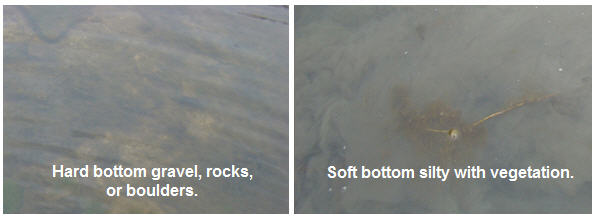
There is a paradox of strategy with many B.A.S.S. tournament anglers. When they fish rivers, anglers often compete for backwater areas without current. When the fishing tournament is held in lakes/reservoirs, they can’t wait until there is current to turn on the bite.
From above, the Allegheny River may look the same but in about a mile I can find areas that are dominant in silt, gravel, rocks, or boulders. Current moves the fine silt particles downstream and deposits them in slower, protected areas. Because of the nutrients carried with it, in general, the more silt, the more productive the fishery. Vegetation often is an indicator of these silty, soft bottom areas.
 However, excessive silt from runoff interferes with spawning, complicates oxygen levels, and coats sensitive gills. And there are seasonal movements to consider. Bass and pike love soft bottom vegetation areas until stressed with excessively warm water in summer. Catfish and carp are more tolerant of silty conditions and less visually dependant for feeding.
However, excessive silt from runoff interferes with spawning, complicates oxygen levels, and coats sensitive gills. And there are seasonal movements to consider. Bass and pike love soft bottom vegetation areas until stressed with excessively warm water in summer. Catfish and carp are more tolerant of silty conditions and less visually dependant for feeding.
If you drop bait on a soft bottom and it may just disappear in the muck. Instead, try rigging it so that your bait will suspend. Use a floating jig head or dropshot to help improve your presentation. Ever drive down a dusty rural road? Dragging a soft bottom with a Carolina rig rubber worm rig can stir up too much of a smoke screen to get a hit, so its better to suspend your bait.
A hard bottom, even though it may have fewer nutrients, means an uneven surface, unlike that of a “flat” of settled silt. With a variation in sizes of rocks, there are places for crayfish and minnows to hide. There also may be higher oxygen content and greater visibility for more sight oriented fish.
“Who wouldn’t want a hard bottom?” asks Bassmaster Elite Tommy Biffle. “I’m always hunting me a rock somewhere.” In fact he has even developed a pivoting jig for his beloved hard bottom areas.
How do you know if the bottom is hard or soft? With practice, an angler can tell by feel of the lure, what is down there. If you are in a boat in less than 8 feet of water, stick the rod tip down and see what you feel. Does it bubble, or release a noxious, anaerobic gas? Your success in that area will depend on time of year and what you are trying to catch.
Sometimes that sweet spot is a transitional area or edge. Next time you are really catching the fish, check the composition of the bottom substrate. When you need to move to a different location, look for a similar mix of rocks, gravel, and silt and you just may find them again.
This article is written by Take Me Fishing blogger Andy Whitcomb, a columnist, outdoor humorist, and stressed-out Dad living in Pennsylvania. Visit him at www.justkeepreeling.com
- 9813 views

